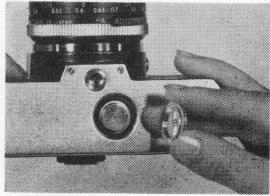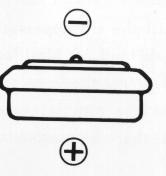IMPORTANT
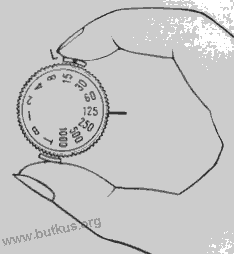 |
In switching light meter
sensitivity selector (4) from high (H) to low (L), or vice-versa, be sure
to press down with fingers 2 levers in front and back of shutter speed
selector knob.
To conserve on batteries, always make sure to have
light meter sensitivity selector (a) on high range side unless light
condition demands shifting to low range necessary.
Sometimes, you may have to open back cover with winding
lever half stroked because old roll is at the end. Before loading a new
roll, be sure to push winding lever all the way to the end of the stroke
in order to reset frame counter to start position (S).
|
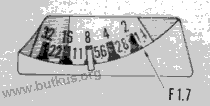 |
The point
which corresponds to F 1. 7 in the exposure indicator is the center between
2 and 1.4 and is indicated by the arrow in the figure on the right. |
LOADING FILM
All 35mm film, black and white, color, 20 or 36
exposures can be used.
Always load film in subdued light.
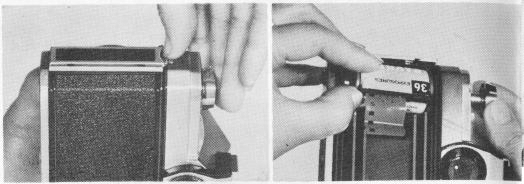 |
1. Open back of camera by pulling out the
slide lock. Pull up the rewind crank knob (15) and insert the 35mm cartridge
in the chamber (16). Return the rewind crank to its former position if it
does not position itself turn handle to right or left until it fits in place
with a click. |
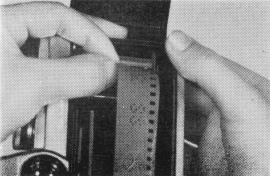 |
2. Turn the take-up spool (18) until the slit appears ; insert end of
the film in the slit (fold end of film for tight fit, if necessary), wind
the film on the spool for one turn. Be sure the lower edge of the film is
against the lower flange of the spool and that the sprocket teeth engage the
film perforations. |
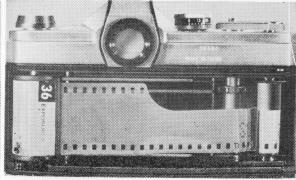 |
3. Next, turn the rewind crank (15) in
direction of the arrow until all film slack is taken up. Check again to make
sure the sprocket teeth engage the film perforations close and lock the
back.
4. The letter S appears opposite the arrow in the exposure counter
window
(5). Advance film a single stroke and depress shutter release button after
each stroke. Continue this until the figure 1 appears opposite the arrow.
The camera is now ready for the first picture. |
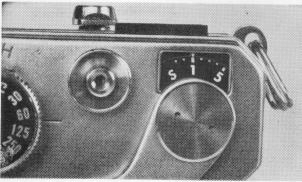 |
6. Each time the film is advanced the rewind
lever will turn this assures proper film action in the camera.
7. The shutter is wound when film is advanced ; next frame can only be
advanced after shutter is released. |
USING THE EXPOSURE METER
The Mamiya/Sekor CWP incorporates a most
advanced and sensitive CdS meter.
It's wide range opens up new picture-taking opportunities . . . . this is how to use it:
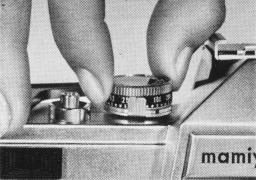 |
1. Lift the shutter speed dial (3) and by
turning match the ASA film speed (22) with the red mark on the lower portion
of the dial. The meter is now coupled to the film speed.
2. Under normal light conditions the sensitivity selector lever (4) is
set on H. This position conserves battery life. For low light conditions set
the selector lever at L. |
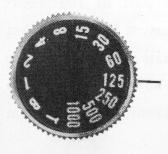 |
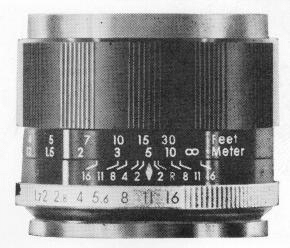 |
3. Now, point the camera at the
subject or scene to be photographed. One of two choices is now possible: (1)
If the shutter speed is important (as in sports events) this should be set first and then the correct exposure regulated by turning the lens
aperture ring (8) until the pointer is centered in the exposure meter window (26). (2) If the depth of field is important (as in scenery, etc.) set the
lens aperture ring to the desired F stop. Then turn the shutter speed dial (3) until the pointer is centered
in the exposure meter window (26). |
 |
4. Shutter speeds are set in click stops. If meter indicates an in-between speed, move shutter to nearest click stop and make adjustment with aperture for proper exposure.
5. When pointer stays in the red portion in either H or L position it indicates too much or insufficient light for picture taking.
The exposure meter is a reflected light type meter; used properly, excellent exposures can be expected every time. Here are some helpful hints on exposure:
Since this type exposure meter measures the light reflected from the object to be
photographed, it is necessary to take a meter reading as near to the object as possible
and thereby exclude extraneous light which can affect the exposure.
Portraits
Approach the subject and take the meter reading close
to the face. If part of the face is darker, measure both
light and dark areas and use the average.
Landscapes
To expose properly for landscapes, tilt the camera
slightly downward, thereby restricting the amount of light
from the sky, which would affect the meter reading.
Backlighting Photography
When shooting a silhouette, measure the light from the
bright part of the background. When an object is to be
photographed by backlighting, measure the light from the
object at close range so that the light from the background will not influence
the meter reading. When the object and the background are
to be photographed at the same time, first measure the
darkest part of the object, then measure the light from
the background and use the average value.
FOCUSING AND VIEWING
The Mamiya/Sekor
CWP is a single lens reflex you
see your picture and take your picture through the same lens. What you see you
will get on the film when yon press the shutter release.
There are no problems of parallax. You obtain perfect composition with any lens
and you can check the depth of field at any time before clicking the shutter.
Furthermore, you can follow the action up to and immediately after the picture
is taken.
FOCUSING
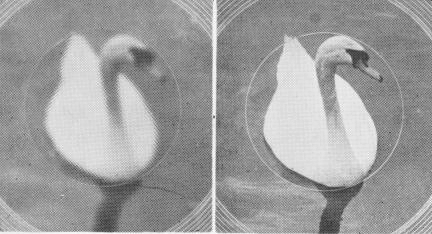 |
The focusing ring (7) is turned in either
direction until the image in the small circle of the finder is sharp. The
micro-diaprism disappears at this point, indicating the sharpest point of
focus. It reappears when out of focus. |
DEPTH OF FIELD
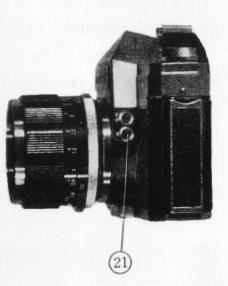 |
To check the depth of field, the preview
lever on the lens (9) is depressed until 'M appears. This closes the
diaphragm to the preselected F value and you can now see exactly the area of
sharpness which will appear in the picture. When the lever is returned, `A'
appears and aperture adjustment becomes automatic. When in "manual"
aperture the viewfinder will become dark until it returns to "A" automatic. |
DEPTH OF FIELD TABLE
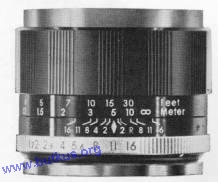 |
Depth of field can also be determined by
consulting the scale on ring(13). This is helpful when the lens is stopped
down so that it cannot be checked with the preview lever due to low light
transmission.
For example, with the standard lens and the aperture set at F
11, focused at 16 feet, the F ii on ,the depth of field ring (13) will point
to approximately 10 feet and infinity. This indicates the range of sharpness
within which all will be in focus. Consult table for other distances
and apertures on page 12. |
Mamiya/Sekor F1.7, 58mm (circle of confusion, 1.
7/1000 inch) -
depth-of-field chart
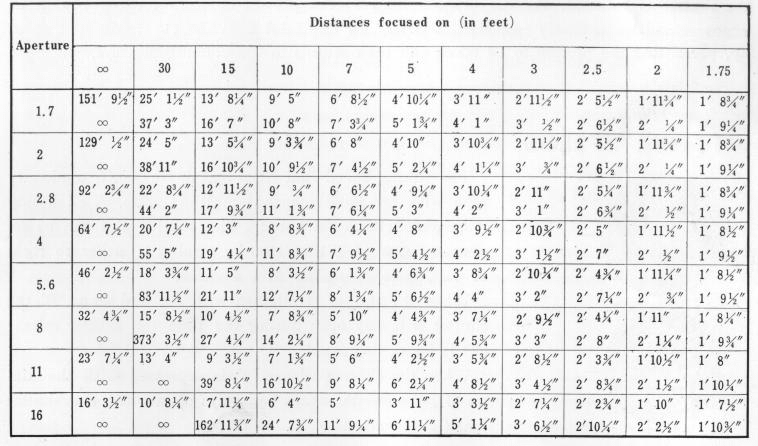
The lens has an automatic pre-set diaphragm. While focusing, it is wide open and provides the maximum brightness in viewfinder for
ease in composing and focusing. When the shutter is released, the diaphragm closes to the pre-set aperture for the instant of
exposure and immediately reopens thereafter. In this brief time the viewing screen snaps up, permitting the picture to be taken
and then returns to the viewing position.
SHUTTER SPEEDS
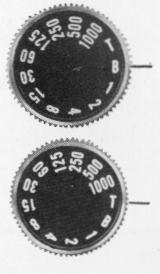 |
The shutter speed dial (3) is a single shaft, stationary type with an equally spaced multiple scale. A click stop is provided for each
speed. The shutter dial can be set over a range of T to 1/1000 by turning it either to right or left, before or after film advance.
When the shutter is released with the dial set on 'B', the shutter will stay open during the time the shutter release (2) is being
depressed.
When the shutter release (2) is depressed with the dial on `T', the shutter opens and stays open until the shutter dial (3) is moved to 'B'. |
SELF-TIMER
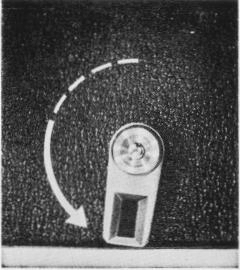 |
This feature makes it possible for the photographer to get in the picture.
It can also be used for slow speeds with camera mounted on a tripod or held
against a stationary object by the photographer.
When the self-timer lever (10) is turned counterclockwise
approximately 180°, the timer allows ten seconds before it trips the
shutter. Time can be adjusted freely over a range of 70° to 180° with the
lever.
When the self-timer actuating button (11) on the lever shaft is
depressed, the timer starts to operate. After the self-timer has been set,
the shutter can still be released by pressing the shutter release button
(2).
In this case, the self-timer action stops. |
Further, before
actuating the self-timer, the shutter must first be wound.
When releasing the shutter with the self-timer, the
automatic aperture control mechanism works
in the same way as when the shutter is released by
depressing the shutter release button.
HOLDING THE CAMERA
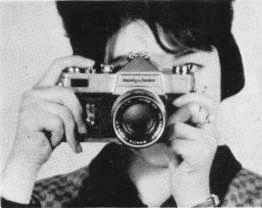 |
Lightly support the bottom of the camera with the palm of the left hand ;
adjust the position of the camera so that the thumb and forefinger of the
left hand can reach the focusing ring (7). Place the palm of the right hand
against the end of the camera body. Then the forefinger of the right hand
will automatically be near the shutter release button (2) and the thumb will
be on the film advance lever (1). Bring the finder window to the level of
the eyes and rest against the forehead. This will assure steady holding of
the camera. |
| In taking vertical pictures, the camera is to be held with the film advance lever upward.
Procedure is the same as for horizontal pictures. Hold the camera with the left elbow as close to the body as possible. |
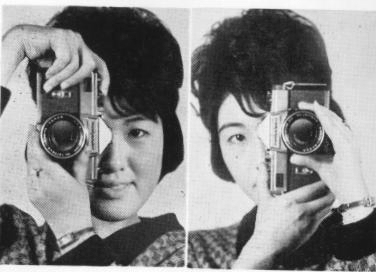 |
|
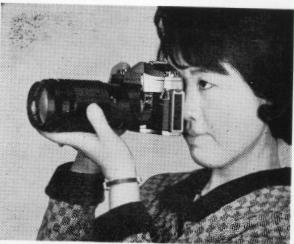 |
When the camera is to be held with the film advance lever (1) downward, with the right thumb on the
shutter release button (2), support the camera with the palm of the right hand. Place the left thumb and forefinger on the focusing ring
(7). Hold the right elbow close to the body.
The above camera positions are the same when other lenses are used.
When taking pictures with speeds of less than 1/30 second, use a tripod or rest the camera on a steady supporting base to prevent movement
when the shutter is released, or when using the self-timer. |
FLASH PHOTOGRAPHY
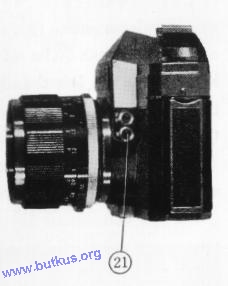 |
The flash terminal (21) has two fittings, one for FP and one for electronic
(X contact).
The relationship between terminal, exposure time and flash bulb
is shown in the table below.
The flash terminal and the shutter speed time dial are
synchronized and indicated by symbols of the same color. When using the FP
flash you can use any of the shutter speeds marked in green on the shutter
speed dial (3). When using the electronic flash you can use any of the
shutter speeds marked in orange on the shutter speed dial (3). |
CHANGING LENSES
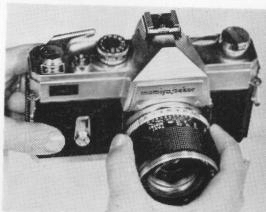 |
To change the lens, hold the lens cylinder in the right hand and turn
counterclockwise. When mounting a lens, turn clockwise until it stops. When
mounting or detaching a lens, hold the section where the depth of field
scale (13) is marked.
When the lens is detached, the reflecting mirror becomes
visible. Never touch this mirror. If dust is found on this mirror, remove by
blowing it away with a rubber bulb or brushing with a camel's hair brush. |
Terminal
|
FP (Green)
|
X (Orange)
|
Exposure time
|
1/1000 sec.-1/60 sec.
|
1/30 sec.-1 sec.
|
Flash bulb
|
Focal plane flash bulbs
|
Electronic or flash bulbs
F and M classes
|
USING INFRA-RED FILM
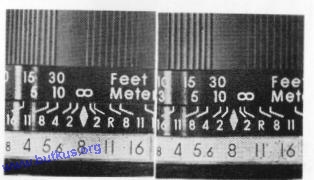 |
With this film, use the red ''R' as the
marker on the depth of field scale (13). After focusing through the
viewfinder note the distance on the distance scale, then turn the ring until
the `R' is opposite the same distance.
If trying IR, go Digital.
Lots of options available. |
UNLOADING FILM
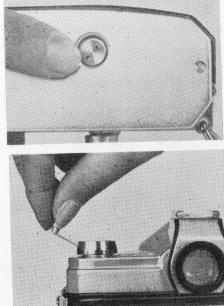
|
After 20 or 36 exposures have been taken,
press the sprocket release button (19), raise the film rewind crank (15) and
turn in direction of arrow. A slight tension can be felt as the film comes
off the take-up spool. Remove the film cartridge from camera.
The sprocket release button (19) returns to its normal position when the film advance lever is operated.
Important : Do not force film advance lever when at end of film. Press the sprocket release button (19) to relieve
tension and then rewind film.
|
ACCESSORIES
The following are available:
Interchangeable lenses
| |
|
|
|
Type Length
|
Speed
(F)'
|
Construction
(element-group)
|
Angle
|
Diaphragm |
Filter Size
(p=0.75)
|
Hood Type |
|
Wide |
28mm |
2.8
|
5-7
|
77° |
Preset |
58mm
|
|
|
Angle |
35mm |
2.8
|
5-6
|
63°
|
Auto |
52mm
|
Screw-in
|
|
Standard |
58mm |
1.7
|
4-6
|
40°50'
|
Auto
|
52mm
|
Screw-in
|
| |
135mm
200mm
400mm
|
2.8
|
4-5
|
18°20'
|
Auto
|
62mm
|
Attached to lens
|
Telephoto
|
4.5
|
4-4
|
12°
|
Preset |
58mm |
Screw-in
Attached to lens |
| |
6.3
|
3-3
|
6°
|
Preset |
72mm |
Screw-in
Attached to lens
|
Extension ring for close-ups 4 per set
Extension bellows
Microscope adapter (for
microphotography)
Angle finder (waist level viewing and focusing)
Lens frame (for eyesight correction lens)
HELPFUL HINTS
Storage of the Mamiya/Sekor
C WP when camera will not be used for a long period
of time).
1. Store without winding the shutter. This relieves spring
tension.
2. Set the light meter sensitivity selector on `H'.
3. Remove mercury battery.
4. Remove camera from carrying case and place inside an air-tight
box with a drying agent (silica gel).
CARE AND CLEANING
1. Never expose camera to direct sunlight for an
extended period of time.
2. When any abnormality is found in the camera, do not attempt to
disassemble or
lubricate. Contact the camera shop where you purchased the
camera, or a service
division of this company.
3. High temperatures of over 100` F and low temperatures of less
than freezing, moisture and salty atmosphere are
injurious to any camera. Every precaution should be taken
for proper care.
Lets Review
1. Load camera-advance film and trip shutter
until exposure 1 appears. 2. Set ASA speed.
3' Set aperture (scenery, etc.) or shutter speed (action) first.
4. Line up pointer in light meter by
turning either aperture ring or shutter speed dial (sec page 7).
5. Focus and compose.
6. Press shutter release button smoothly.
Presto! :
You have taken a perfectly exposed picture with your Mamiya/Sekor
CWP and we hope it's a
prize-winner!




